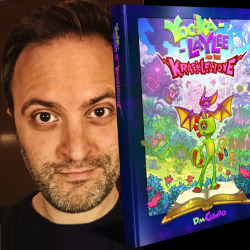
Rare Gamer Interviews ‘Yooka-Laylee and the Kracklestone’ creator, Dave Cumbo
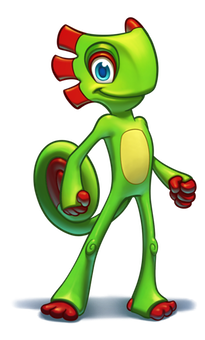
Recently we had the pleasure of getting in touch with artist Dave Cumbo, the mind and talent behind the upcoming Kickstarter for the Yooka-Laylee Graphic Novel and founder of Dreamprism Press for a bit of a chat. Join us as we discuss his artistic career, his involvement with past video game franchises at Insomniac Games, his favorite Rare titles that served as inspiration and the behind-the-scenes process for his impressive undertaking involved with creating Yooka-Laylee and the Kracklestone…
First, can you tell us a bit about your work? As fans of Ratchet, Banjo and Yooka, we do have a soft spot for ‘buddy platformers’.
I’ve had a strange, zig-zagging career thus far. I started in animation, progressed to cinematic storyboarding and layout, and finally to writing and illustrating books. The unifying factor has always been a desire to realize my concepts into some form of visual story medium. When I finished animation school in 2003, I strongly wanted a job in film production but kept getting advice to move into video game production. At the time, game animation was rather crude in general. So, despite my love for games, this wasn’t a very appealing proposition. However, I did have one game studio in mind… Rare. I loved Rare’s 90’s classics! As it turned out, I ended up at Insomniac Games not long after and had the good fortune to work on the Ratchet and Clank series. After several years, I moved into illustrated books and graphic novels.
We’re very excited to see what’s in store for the Yooka Laylee graphic novel, how did your relationship with Playtonic Games come about?
I have Grant Kirkhope to thank for that! I got to know Grant a bit when he first moved to the USA and was working on Kingdoms of Amalur. I’d been pressuring him to get “the band” of Rare devs from the N64 days back together (mainly so I would have a new Banjo-type game to play). I didn’t have any expectation such a thing would actually end up happening.
Before I left Insomniac to develop my original book series called Dreamside, I’d been thinking about working with game studios to adapt cool properties into comics/graphic novels. One of the first people I approached was Shantae creator Matt Bozon at WayForward to do a graphic novel based on Shantae. But, the timing wasn’t right. When Yooka-Laylee (the game) appeared on Kickstarter, I knew immediately that it was the right project to adapt. I didn’t know anything about it that wasn’t shown in the campaign, but it was clear in my mind. I had to pursue it.
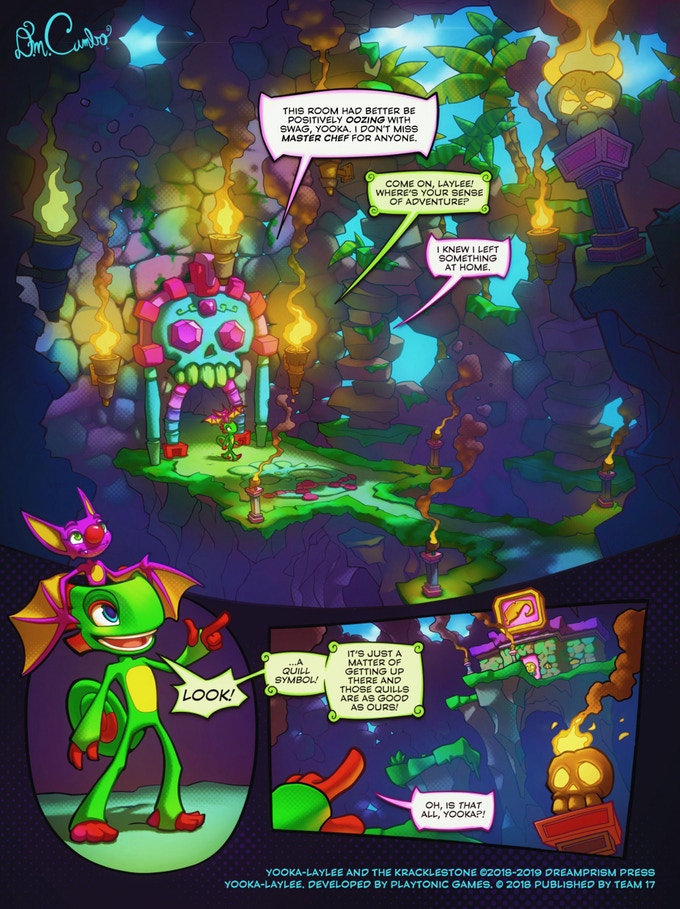
The promotional images we’ve seen for the Yooka Laylee graphic novel are very impressive, very striking and dynamic – colorful as well! What is your process for creating your work?
I have a pretty exhaustive coloring process to get the pages to look the way they do. My general philosophy is two-part: make every illustration “cover-art” quality and each page should be a singularly-appealing work of art in itself. I go through a few extra stages that take a long time but really make the art pop in a graphically powerful manner. For example, I use color gradients extensively. If there is a patch of grass, I’ll have the hue shift from yellow to blue and, maybe, a bit of another color added for spice. I also try and simulate an effect from the computer graphics world called radiosity—which is the effect of light bouncing around a scene carrying color along with it. By understanding how light bounces in a 3d scene, you can go a long way toward creating a strong sense of realism and beauty. In general, I want the reader to be constantly surprised by the quality as they move through the book. I want it to be as stunning as possible.
What are some of the challenges that arise during the creation of a graphic novel, and how are they tackled?
Well, the biggest challenge for this project was that I worked unpaid for two years! I never lost faith in the project’s potential, so I’d focus on potential future success to squash the daily fears that would rise up. I expected the project to take no longer than ten months when it was first pitched. When I reached that point, it was too late to quit as I’d fallen in love with the book and absolutely had to see it through. I didn’t know it would end up a two and half year production—roughly as long as the game took to make!
Besides those, I also had the challenge of adapting the characters and world into a book, which is harder than it might seem. Comics, especially ones with loads of close-ups and expressive shots, have different needs than games. I felt I had to tweak the characters for this purpose and, fortunately, had the blessing of Playtonic Games to do so as needed. Of course, they checked it throughout development to be sure I wasn’t getting too far off-track.
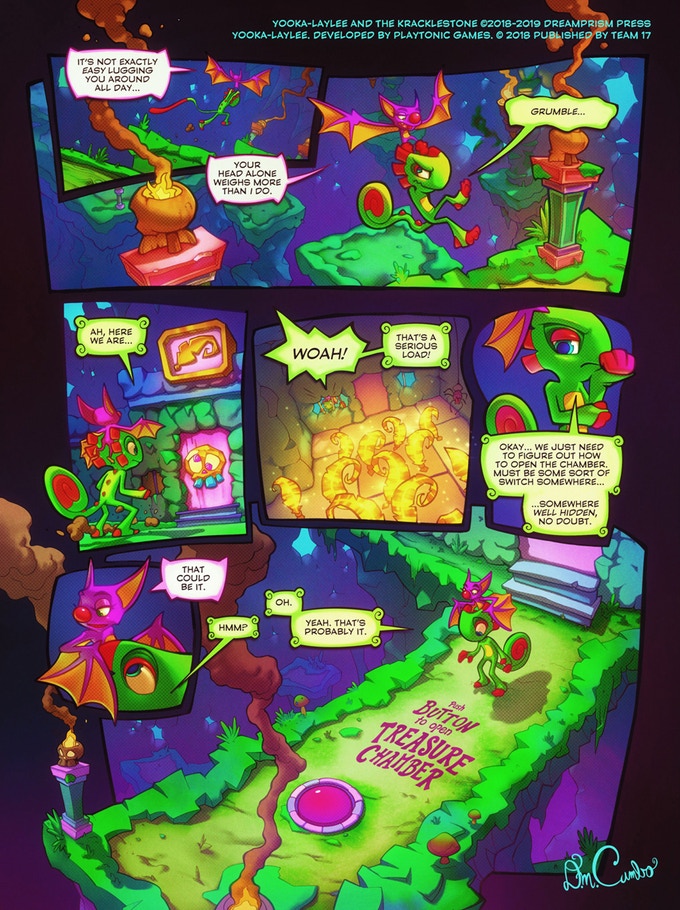
We’ve been told you’re a fan of some of Rare’s classic titles – what games helped inspire you towards working with Yooka Laylee?
In addition to Yooka-Laylee itself, I was primarily influenced by three Rare titles: Donkey Kong Country, Banjo-Kazooie, and Jet Force Gemini. All three were childhood favorites and games I continue to play today. When I think deeply about them, I know each would be incredible foundations for graphic novel adventures… as long as those books could capture the magical feelings I have about the games. It’s very hard to understand nostalgia and how it affects us. Further, it’s difficult to know how readers will respond to it. I thought that I would be able to squeeze all that love I have for these games into this book. But, one book isn’t nearly enough to accomplish that….
Do you have a favorite Rare or Insomniac Games title? What pushes them into your personal choice?
The three mentioned above are my overall favorite Rare games (though I do prefer DKC2 to the first game). As for Insomniac, I’d have to say Spyro the Dragon. It was made way before my time at the company but I liked the colorful fantasy setting and exploratory nature of the game.
On the topic of inspiration, who are some of your favorite artists or writers?
I have a lot of favorite artists/studios so I’ll just mention a few: Tomomi Kobayashi, Wendy Pini, Stephen Gammell, Clamp, Junji Ito, John Tenniel, and Rumiko Takahashi. As far as writers, Lewis Carroll, Michael Ende, and Stephen King. I also want to specifically call out Steve Mayles from Playtonic/Rare for creating so many wonderful characters with whom I’m now working!
What has been the most fun in creating the Yooka Laylee graphic novel so far?
I get the greatest satisfaction when I complete a page well. If the art appeals heavily to me, I feel a sense of euphoria that’s really hard to capture on a day-to-day basis (and is overpowered by long periods of frustration as I try and work through story and art challenges). I’ve enjoyed the freedom Playtonic granted me to work with their amazing characters and worlds. It’s a blast to be able to take what I think is great about the game(s) and expand it into a book. It may sound a bit sappy, but its quite moving to be able to “respond” to the people who developed so many of the classic games I enjoyed as a kid.
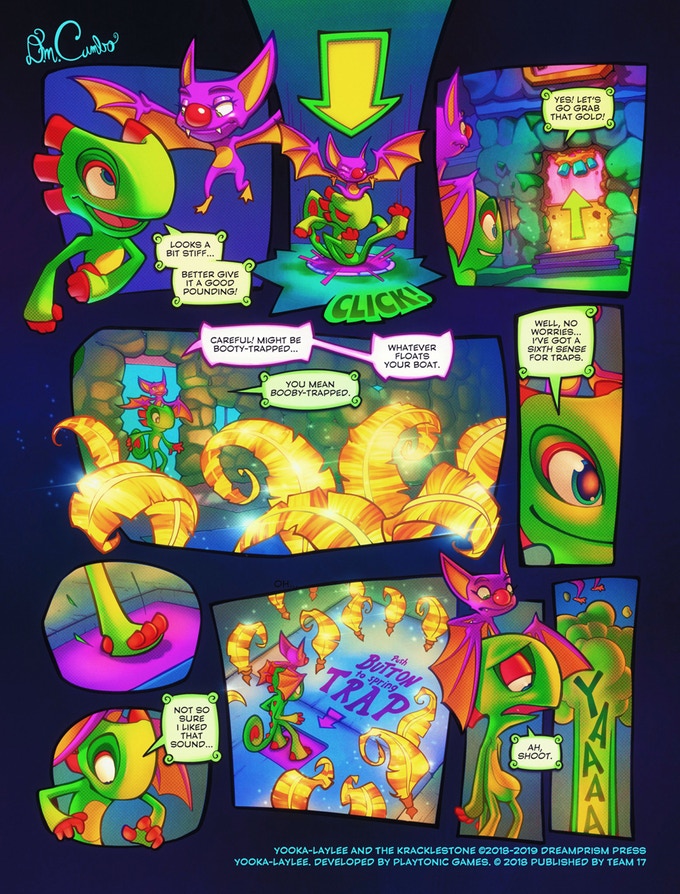
We expect to visit some familiar locations in Yooka’s first adventure – what has been your favorite world to recreate in that respect?
Actually, the only world in the book that’s also in the game would be the Shipwreck Creek/Hivory Towers area and we get to see a few new parts of the factory. Even the intro scene’s location is kept mysterious to avoid conflict with the game’s collectable logic. I wanted the game to have a startling amount of new content so it feels almost like getting a sequel of sorts… just in a different format. As for my favorite world to create… that would be a toss-up between Plum Pedal Meadow and Fungi-side Forest. I really love the fantasy levels in Banjo-Kazooie and Donkey Kong 64 such as Click Clock Wood and Fungi Forest. So, I wanted to make sure the book had one or two homages to them.
What advice would you give someone looking to create their own graphic novel, or get involved in the games industry?
Both industries are easier than ever to break into due to the range of (comparably) inexpensive tools available. With a reasonably capable computer, you can download Blender and Unity, watch a bunch of free YouTube tutorials, and get started making games right away! Whenever I want to learn to do something technical, I look it up on YouTube and, somehow, what I need to know is readily available in an instant. Of course, the tools only provide access. You’ll have to spend time practicing and developing your skills. My general advice is to identify a clear goal toward which you can work. It helps you push through the challenges of development if you can see the finish product in your mind. Don’t wait. Start right now. Even if you’re not very skilled, that will get better automatically as you work.
We’d like to extend our thanks to David Cumbo for his time, and wish him the best with his Kickstarter campaign. Want to show your support? There’s still time to contribute to Yooka-Laylee and the Kracklestone to help the project reach fruition and earn some nifty backer rewards in the process!
Categories: Interviews, News
0 Comments
This post has been left all alone with no comments. Don't leave it lonesome - give it some company with a comment.